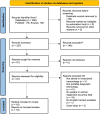Portable stroke detection devices: a systematic scoping review of prehospital applications
- PMID: 35710360
- PMCID: PMC9204948
- DOI: 10.1186/s12873-022-00663-z
Portable stroke detection devices: a systematic scoping review of prehospital applications
Abstract
Background: The worldwide burden of stroke remains high, with increasing time-to-treatment correlated with worse outcomes. Yet stroke subtype determination, most importantly between stroke/non-stroke and ischemic/hemorrhagic stroke, is not confirmed until hospital CT diagnosis, resulting in suboptimal prehospital triage and delayed treatment. In this study, we survey portable, non-invasive diagnostic technologies that could streamline triage by making this initial determination of stroke type, thereby reducing time-to-treatment.
Methods: Following PRISMA guidelines, we performed a scoping review of portable stroke diagnostic devices. The search was executed in PubMed and Scopus, and all studies testing technology for the detection of stroke or intracranial hemorrhage were eligible for inclusion. Extracted data included type of technology, location, feasibility, time to results, and diagnostic accuracy.
Results: After a screening of 296 studies, 16 papers were selected for inclusion. Studied devices utilized various types of diagnostic technology, including near-infrared spectroscopy (6), ultrasound (4), electroencephalography (4), microwave technology (1), and volumetric impedance spectroscopy (1). Three devices were tested prior to hospital arrival, 6 were tested in the emergency department, and 7 were tested in unspecified hospital settings. Median measurement time was 3 minutes (IQR: 3 minutes to 5.6 minutes). Several technologies showed high diagnostic accuracy in severe stroke and intracranial hematoma detection.
Conclusion: Numerous emerging portable technologies have been reported to detect and stratify stroke to potentially improve prehospital triage. However, the majority of these current technologies are still in development and utilize a variety of accuracy metrics, making inter-technology comparisons difficult. Standardizing evaluation of diagnostic accuracy may be helpful in further optimizing portable stroke detection technology for clinical use.
Keywords: Diagnosis; Emergency medical services; Prehospital; Stroke; Technology.
© 2022. The Author(s).
Conflict of interest statement
Dr. De Leacy is a consultant for Stryker, Penumbra, Siemens, and Cerenovus. Dr. Mokin is supported by a grant from the NIH (NIH R21NS109575) and is a consultant for Medtronic and Cerenovus. Additionally, Dr. Mokin is an investor in BrainQ, Endostream, Serenity medical, Synchron. Dr. Fifi is a stockholder in Cerebrotech. Dr. Mocco is the PI on research trials funded by: Stryker Neurovascular, Microvention, and Penumbra and he is an investor in: Cerebrotech, Imperative Care, Endostream, Viseon, BlinkTBI, Myra Medical, Serenity, Vastrax, NTI, RIST, Viz.ai, Synchron, Radical, and Truvic. He serves, or has recently served, as a consultant for: Cerebrotech, Viseon, Endostream, Vastrax, RIST, Synchron, Viz.ai, Perflow, and CVAid. Dr. Kellner has received research grant support from Cerebrotech, Siemens, Penumbra, Minnetronix, Viz.AI, Integra, Longeviti, and Irras and has ownership in Metis Innovative and Precision Recovery. The remaining authors have no conflicts of interest to declare.
Figures
Similar articles
-
Prehospital identification of intracerebral haemorrhage: a scoping review of early clinical features and portable devices.BMJ Open. 2024 Apr 19;14(4):e079316. doi: 10.1136/bmjopen-2023-079316. BMJ Open. 2024. PMID: 38643005 Free PMC article.
-
A systematic review of next-generation point-of-care stroke diagnostic technologies.Neurosurg Focus. 2021 Jul;51(1):E11. doi: 10.3171/2021.4.FOCUS21122. Neurosurg Focus. 2021. PMID: 34198255
-
Non-invasive sensor technology for prehospital stroke diagnosis: Current status and future directions.Int J Stroke. 2019 Aug;14(6):592-602. doi: 10.1177/1747493019866621. Epub 2019 Jul 26. Int J Stroke. 2019. PMID: 31354081 Review.
-
Technological innovation for prehospital stroke triage: ripe for disruption.J Neurointerv Surg. 2019 Nov;11(11):1085-1090. doi: 10.1136/neurintsurg-2019-014902. Epub 2019 Jun 14. J Neurointerv Surg. 2019. PMID: 31201289 Review.
-
Modern Prehospital Screening Technology for Emergent Neurovascular Disorders.Adv Biol (Weinh). 2023 Oct;7(10):e2300174. doi: 10.1002/adbi.202300174. Epub 2023 Jun 25. Adv Biol (Weinh). 2023. PMID: 37357150 Review.
Cited by
-
Detecting Stroke at the Emergency Department by a Point of Care Device: A Multicenter Feasibility Study.Med Devices (Auckl). 2024 Mar 5;17:107-112. doi: 10.2147/MDER.S445075. eCollection 2024. Med Devices (Auckl). 2024. PMID: 38476129 Free PMC article.
-
Prehospital identification of intracerebral haemorrhage: a scoping review of early clinical features and portable devices.BMJ Open. 2024 Apr 19;14(4):e079316. doi: 10.1136/bmjopen-2023-079316. BMJ Open. 2024. PMID: 38643005 Free PMC article.
-
Prehospital neurological emergencies- a survey on the state of prehospital neurological assessment by emergency medical professionals.BMC Emerg Med. 2024 Sep 11;24(1):164. doi: 10.1186/s12873-024-01076-w. BMC Emerg Med. 2024. PMID: 39256650 Free PMC article.
-
Portable cerebral blood flow monitor to detect large vessel occlusion in patients with suspected stroke.J Neurointerv Surg. 2025 Mar 17;17(4):388-393. doi: 10.1136/jnis-2024-021536. J Neurointerv Surg. 2025. PMID: 38514189
-
Ultra-early versus early surgery for hip fracture.Cochrane Database Syst Rev. 2024 Jun 13;6(6):CD015697. doi: 10.1002/14651858.CD015697. Cochrane Database Syst Rev. 2024. PMID: 39804112 Free PMC article.
References
Publication types
MeSH terms
LinkOut - more resources
Full Text Sources
Medical


